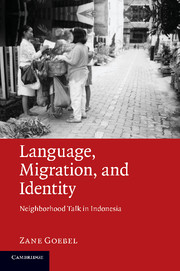Book contents
- Frontmatter
- Contents
- Figures
- Diagrams
- Maps
- Tables
- Extracts
- Preface
- Conventions
- 1 Introduction
- 2 Long-term Processes of Enregisterment
- 3 Enregistering Local Practices and Local Spaces
- 4 Linguistic Signs, Alternation, Crossing, and Adequation
- 5 Women, Narratives, Identity, and Expectations in Ward 8
- 6 Learning to Become a Good Ward Member
- 7 Emerging Identities in a Monthly Ward 8 Male Meeting
- 8 Chineseness as Deviance
- 9 Language Ideologies and Practice in Ward 5
- 10 Conclusions
- Notes
- References
- Index
4 - Linguistic Signs, Alternation, Crossing, and Adequation
Published online by Cambridge University Press: 04 August 2010
- Frontmatter
- Contents
- Figures
- Diagrams
- Maps
- Tables
- Extracts
- Preface
- Conventions
- 1 Introduction
- 2 Long-term Processes of Enregisterment
- 3 Enregistering Local Practices and Local Spaces
- 4 Linguistic Signs, Alternation, Crossing, and Adequation
- 5 Women, Narratives, Identity, and Expectations in Ward 8
- 6 Learning to Become a Good Ward Member
- 7 Emerging Identities in a Monthly Ward 8 Male Meeting
- 8 Chineseness as Deviance
- 9 Language Ideologies and Practice in Ward 5
- 10 Conclusions
- Notes
- References
- Index
Summary
Introduction
In work in multilingual settings the use of linguistic signs in semiotic encounters is often talked of in terms of code choice and codeswitching. Arguably, the most well known approaches are those offered by Gumperz (1982a) and Myers-Scotton (1993). Both approaches see identity as a central factor in language choice and codeswitching. For example, Gumperz (1982a: 66) based much of his approach on the perceived association of different languages with the identities of in-groups or “we” and out-groups or “they”, although he does note that such relationships do not predict how interactional codeswitching may progress. Myers-Scotton's (1993) markedness model sees participants' motivations for choosing one code instead of another as reflecting wider societal relationships between identity and language. In her approach, the analyst is able to interpret participants' code choice if they know participants' social identity in terms of such things as ethnicity.
However, Myers-Scotton's approach has been problematized by those working in ethnographic and ethnomethodological paradigms (e.g. Meeuwis & Blommaert, 1994; LiWei, 1998). For example, Meeuwis and Blommaert (1994) have noted its over-reliance on Chomskian mentalist concepts of competence, its lack of attention to ethnographically recoverable social factors influencing access to codes, its over-simplification of language–identity relationships (especially the reliance on imagined place-based ethno-linguistic categories), and the need to define community and the associated assumptions of sharedness of experience in any community. In a later paper (Meeuwis & Blommaert, 1998), they continue this critique by arguing that this approach is based on the false assumption that those who codeswitch must be bilingual.
- Type
- Chapter
- Information
- Language, Migration, and IdentityNeighborhood Talk in Indonesia, pp. 58 - 75Publisher: Cambridge University PressPrint publication year: 2010

